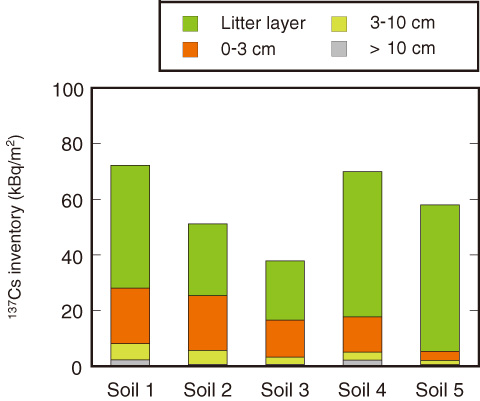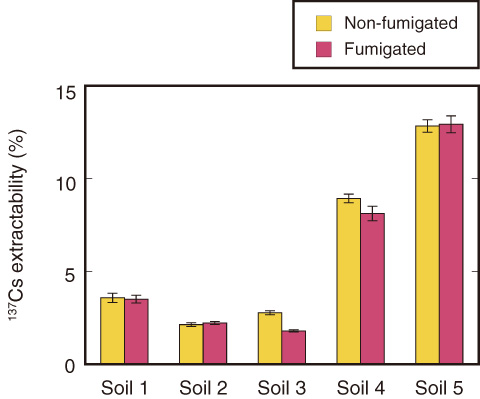
Fig.1-16 Vertical distribution of 137Cs in forest soils three months after the accident
 ) and the topmost (0-3 cm) soil layer (
) and the topmost (0-3 cm) soil layer ( ), respectively.
), respectively.

Fig.1-17 Extractability of 137Cs in five forest surface (0-3 cm) soils
The accident at the TEPCO’s Fukushima Daiichi NPS released a huge amount of radiocesium into the environment and caused serious radioactive contamination of forest ecosystems. Our investigation, which was conducted in Fukushima Prefecture three months after the accident, revealed that >89% of the cesium-137 (137Cs) deposited onto forest floors remained in the aboveground litter and topmost (0-3 cm) soil layers (Fig.1-16). In forest ecosystems affected by the accident at the Chernobyl NPS in 1986, 137Cs has reportedly still been observed in surface soils and has become a major potential source for soil-to-plant transfer. Therefore, a better understanding of the mechanisms of retention and migration of 137Cs in forest surface soils is urgently needed.
We focused on microbial involvement in the retention process of mobile 137Cs in forest surface soils because some types of microorganisms in soils are believed to accumulate 137Cs and thus influence the cycling of 137Cs in forest ecosystems. Surface (0-3 cm) soil samples were collected from five forest sites in Fukushima Prefecture one year after the accident, and the following experiments were conducted.
First, soils were extracted with potassium sulfate (K2SO4) solution, and the extracts were analyzed for 137Cs. The extraction process liberated 2.1%-12.8% of the total 137Cs as easily exchangeable ions from the soils. Two soils with a higher content of clay-sized particles and organic carbon showed higher 137Cs extractability (Fig.1-17, Soils 4 and 5). Next, the soils were fumigated with chloroform to destroy microbial biomass and then extracted with K2SO4. Microbial biomass was extracted from all of the soils; however, no increase in the 137Cs extractability was observed (Fig.1-17).
The results indicate that the uptake of 137Cs by soil microorganisms is less important for retention of mobile 137Cs in the forest surface soils than ion-exchange adsorption by abiotic components. We are now conducting a similar experiment on litter and soil samples collected under different meteorological conditions to fully understand the role of soil microorganisms in controlling the mobility of 137Cs in natural biotic systems.
The present study was sponsored in part by the Ministry of Education, Culture, Sports, Science and Technology of Japan (MEXT).